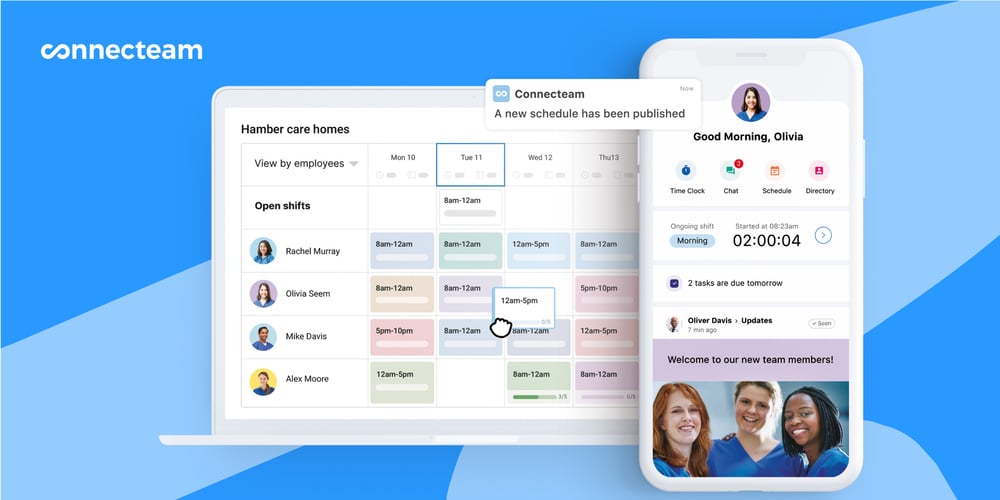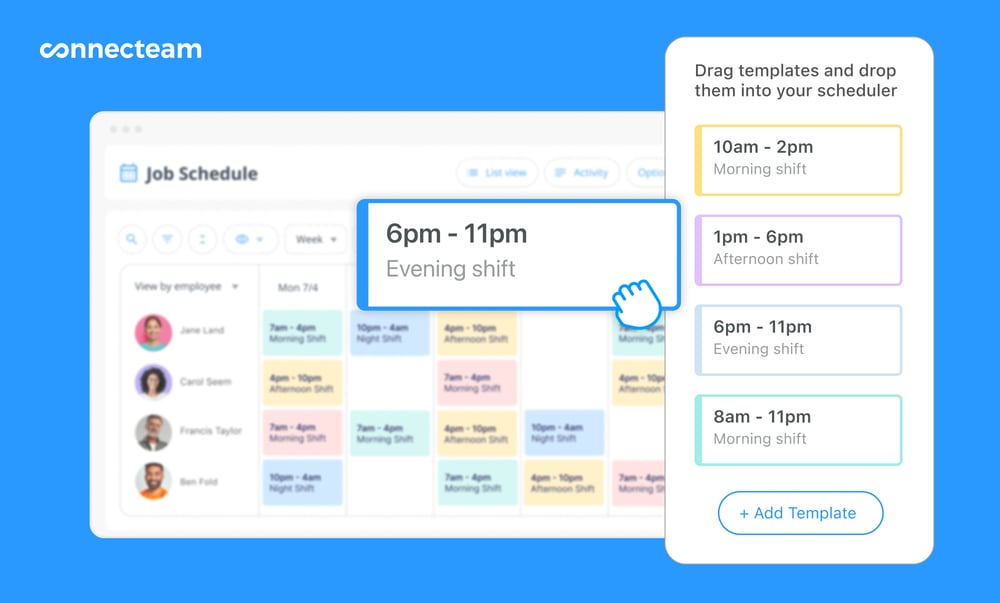Learn how to create work rotas for your UK business that comply with employment laws and regulations. We cover the rules you need to know and share best practices for building a work rota that works for your business.
Ensuring your business has the right employees scheduled to work at the right time can be time-consuming and frustrating. Establishing a work rota can help, but you must account for more than just your business’s needs. Employee working time in the UK is subject to several legal regulations that affect how you set up a work rota.
In this guide, we outline the legal requirements you need to know to build compliant work rotas that save on labour costs. We also go over ways to streamline scheduling so you can remove the headache from creating work rotas and keep your business running smoothly.
What Is a Work Rota?
A work rota is a working schedule that:
- Identifies work team members must perform
- Sets a schedule for completing the work
- Identifies who will carry out the work
Employers use work rotas to set expectations for when their employees will work. Rotas also ensure employees have adequate breaks and that team members complete work tasks on time.

UK Laws That Impact Your Work Rota
Work rotas should take business needs into consideration, but they’re also required to comply with several UK employment laws. Legal requirements impact when you can schedule employees to work, how much they can work, and when they’re entitled to breaks.
Maximum working hours
The Working Time Regulations 1998 sets maximum working hours in the UK. Under these regulations, employees can work a maximum of 48 hours per week. Employees can opt out of this restriction but must do so voluntarily and in writing.
Working hours include any time the employee is carrying out work duties or acting under the direction of their employer. This includes travel time during the work day, time working away from home, and time spent on-call at the workplace.
Working hours don’t include rest time such as lunch breaks. They also don’t include rest times when the employee is away from home overnight or on-call while they’re away from the workplace and not performing any work.
You must keep an accurate record of the hours your employees work to avoid accidentally scheduling too many working hours.
Night work
In addition to maximum working hours, the Working Time Regulations 1998 sets rules for work performed at night. Night workers may not work more than an average of 8 hours in a 24-hour period.
Calculating whether an employee has worked more than 8 hours as a night worker can be tricky. The 8 hours are calculated as an average over 17 weeks. So, it’s possible for the employee to work longer shifts as long as they’re compensated with rest time. You can extend the 17-week period to a maximum of 52 weeks if you and your employee agree.
Any employee who regularly works 3 or more night hours is considered a night worker. Night hours typically run from 11pm-6am. That said, you can define night hours differently in an employment contract.
Employees under age 18 are restricted from most work between 10pm and 6am. Some exceptions exist for specific industries like agriculture. There’s also an exception that allows employers to employ a 16- or 17-year-old when they can prove that no adult is available to do the work.
🧠 Did You Know?
Connecteam’s time clock has a shift report functionality that automatically displays hours worked based on the date the work was performed. This makes it much simpler to accurately calculate an employee’s weekly working hours when a night shift falls across 2 working weeks.
Overtime
There’s no legal requirement for employees in the UK to work overtime.
Similarly, there’s no requirement for a UK employer to offer overtime hours or pay higher wages for overtime work as long as the employee’s average pay doesn’t fall below the national minimum wage.
As an employer, you should include details for any overtime pay and calculation methods in the employment contract. For example, “time and a half” is an overtime calculation method often required in the US and commonly used in UK employment contracts. An employee with this term in their contract would be paid their normal hourly rate plus 50% of that rate for each overtime hour worked.
💡 Pro Tip:
Regularly scheduling employees for overtime will also impact how much you must pay when that employee takes statutory paid holiday. The amount an employee is entitled to earn for their statutory paid holiday includes their average overtime earnings. You must track overtime correctly to ensure payroll is accurate year-round.
Rest breaks
As a UK employer, you must provide breaks during and between employees’ shifts. You must also provide uninterrupted rest periods on a weekly or fortnightly basis. Rest periods are typically unpaid, but you can alter this in the employment contract.
During a work shift of 6 hours or more, an employee is entitled to 1 20-minute rest break. Usually, this would be the employee’s lunch break. Workers should take this break mid-shift rather than near the beginning or end of a shift. You can set out longer rest breaks by policy.
Employees have a right to 11 hours of rest between work shifts. For example, an employee who ends work at 11pm one night can’t work again until 10am the following morning.
Employees must also have uninterrupted rest time—time with no work requirements—equal to at least 24 hours each week, or 48 hours each fortnight.
Part-time employees
The Part-time Workers (Prevention of Less Favourable Treatment) Regulations 2000 require employers to offer the same entitlements on work hours and shift patterns to part-time employees as they would to full-time employees. This includes offering the same rest breaks during and between shifts.
Notice of work hours
UK law doesn’t establish a hard deadline for notifying employees of the work rota. However, “reasonable” notice is required.
💡 Pro Tip:
A good rule of thumb is to post the work rota 1 week before the scheduled shifts.
Changes to work hours
Under UK law, there’s no definite time period for changing a work rota.
That said, you must give employees reasonable notice of changes to their work hours. Making a one-time temporary change is generally acceptable if you give employees 24 hours’ notice. Permanent changes and changes large businesses make often require a longer notice period.
🧠 Did You Know?
Employees have the legal right to request flexible working, which may include requests to accommodate adjustments to their specific shift hours.
Recordkeeping requirements for work rotas
Work rotas shouldn’t be discarded after scheduled shifts have concluded. These are legal documents and can be a piece of evidence in employment disputes or other legal proceedings. UK law requires you to keep working time records for 2 years from the date they were made.
How To Set a Work Rota
Creating an effective rota seems simple, but it can swiftly become challenging. Here are some common models to keep in mind and best practices for setting up a work rota.

Work rota management best practices
When creating and managing a work rota, be sure to:
- Follow employee contract terms. Different employees may be contracted for different maximum working hours and working hour schedules. Scheduling software, such as Connecteam, makes tracking these different rules easier and less prone to error.
- Set clear rules for who may create or change a work rota. Limit who can alter work rotas to avoid accidental mis-scheduling or understaffing.
- Create an approval process for employee time requests. While you want to respond to employee requests quickly, you should treat all requests equally and fairly. Additionally, you should consider business needs before approval.
- Balance skill needs for each shift. For instance, you wouldn’t want to staff your restaurant with only wait staff while leaving out cooks. Ensure your schedule includes workers with the right skills required for each task that needs to be completed.
- Ensure adequate supervision. You shouldn’t ask employees to work without access to a line manager or supervisor. This can lead to mistakes, delays, and even accidents and injuries.
- Create a contingency plan for absences. Illness and other unexpected absences can throw your staff rota out the window. Consider an on-call rotation or other backup plans to ensure adequate staffing.
- Have a plan for employee concerns. Make sure employees are clear on who they can speak to if they have a concern with their shifts.
- Establish a policy on shift swapping. Be clear on how often they can swap shifts and who they should submit swap requests to (if not you).
Traditional work rota models
Work rota planning involves shifts that vary in length. You may want to experiment with different models to find the shift patterns that work best for your business.
The most common work rota models include:
- 2 shifts. This model divides the workday between 2 employee shifts. For instance, a retail employer might have an early shift from store opening to midday and a late shift from midday to store closing. Employees can be permanently assigned to early or late shifts or regularly rotate from one to the other.
- 3 shifts. This model divides the workday into 3 employee shifts. This pattern is more common for a 24-hour business, such as nursing care. Shifts are often split to include 2 daytime shifts (such as 6am-2pm and 2pm-10pm) and 1 night shift (such as 10pm-6am). Employees can be permanently assigned to one shift or rotate periodically between the available shifts.
- Staggered. This model schedules shifts for 5 working days but spreads them over a 6- or 7-day period to provide coverage on the weekend. Employees working a weekend day get a compensating weekday off instead.
Work rota models can also include customised options like twilight shifts in the early evening, weekend-only, or 12-hour shift patterns.
📚 This Might Interest You:
Learn how to lower employee turnover when scheduling shift-based work.
You might also want to read our in-depth review of the best staff rota software of 2025
Use Connecteam to Simplify Your Work Rota
Setting up effective work rotas can take a huge amount of time, but you can streamline the process with the right software.

Connecteam’s powerful employee scheduling features make creating your work rota easy and help you avoid costly errors. Here are some reasons you should consider using Connecteam:
- Streamlined scheduling. Use templates, duplications, and recurring employee shifts to save valuable time and effort when creating work rotas for your employees.
- Legal compliance. Set custom overtime, break, and time off rules to ensure your work rotas comply with labour laws and regulations.
- Optimised schedules. The app gives you full visibility into your employees’ availability, qualifications, time-off requests, and preferences. This helps avoid conflicts or double bookings.
- Quick distribution. Publish work rotas with 1 touch of your device and share them with employees through the app. No need to manually share hard copies.
- Mobile access to information. Connecteam’s mobile app provides your team members with on-the-go access to all the information they need to succeed.
- Real-time communication. The in-app chat and updates feed enable you to communicate with your employees instantly, eliminating the need for separate calls or texts.
- Shift reminders and replacements. Automate shift reminders to ensure full staff schedules and prevent no-shows. When an employee calls in sick, you can quickly find replacements using the app.
- Time tracking and reporting. Connecteam’s app allows staff to clock in from their phones, making it easy to record accurate work hours and calculate overtime, breaks, and time off. You can directly export timesheets to payroll software for smooth processing.
- Employee input. Your workers can check their schedules, request swaps, and submit leave requests on their own through the app. This gives them more flexibility, holds them accountable, and reduces confusion over scheduling changes.
Get started with Connecteam for free today!
Create a Legally Compliant Work Rota for Your Business
Implementing an effective work rota is essential to ensure smooth operations. However, complex regulations and varying employment contract terms can turn simple scheduling into a huge task.
By implementing best practices and staying aware of your legal requirements, you’ll be well on your way to creating successful, compliant work rotas.
Connecteam’s scheduling app can help you stay on track—you can easily avoid errors, stay compliant, and keep your employees informed of their shifts in real time from anywhere.



